2014年01月31日
Takamatsu Stone Museum
I stopped by the Takamatsu Stone Museum the other day to catch Luca Roma’s latest exhibition “Thin Lines”.

An Italian sculptor resident in Mure, Takamatsu, Luca Roma does amazing things with wood, metal and other materials.

Luca arrived in Japan in 2000 to work with a Japanese sculptor in Ehime. He subsequently moved to Takamatsu where in 2004 he became the first foreign resident to win the Governor’s Award for sculpture.


I found “Thin Lines” warm, inviting, playful, and, at the same time, thought-provoking. As my photos can’t possibly do his work justice, I encourage you to go and see for yourself. The exhibition runs until this Sunday, February 2nd. (For a little more on Luca Roma see:
http://www.yashima-artvillage.jp/english/artist/category06.html#name02 )
While at the museum (entrance fee only 200 yen, under 18 free), you can enjoy a trip into the area’s history of stone quarrying, masonry and sculpture.
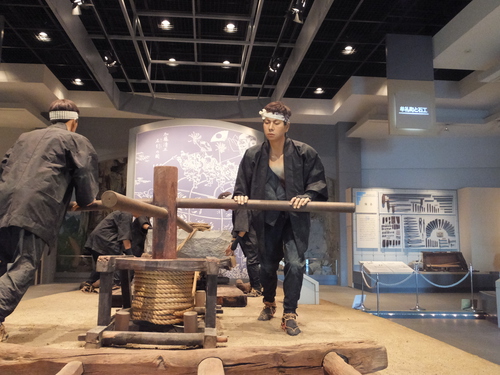
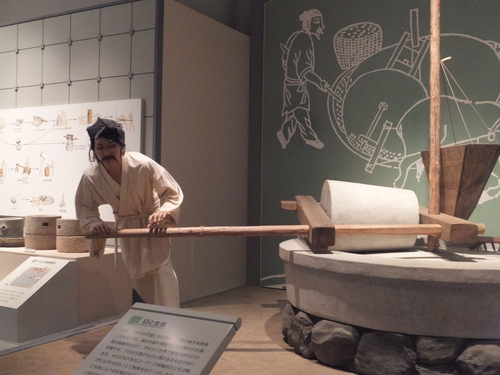
Although there are no English explanations, the displays provide graphic depictions of various aspects of this local industry, which has been passed down faithfully for centuries. These skills developed thanks to a rich quarry of fine granite (Aji-ishi) located not far from the museum.
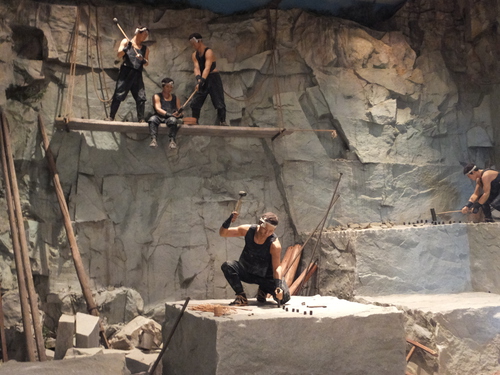
You can see evidence of the quality of local masons in every stacked stone wall you see in Takamatsu. And there are many of them!

Although the displays are impressive and well worth seeing, I was skeptical as to whether the museum had many visitors. I mean, after you’ve seen the main exhibit once or twice, would you keep coming back?
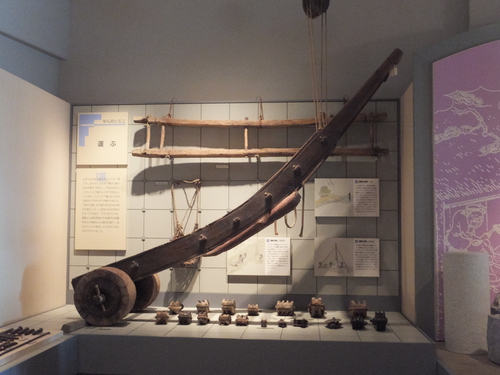
The receptionist assured me, however, that even in winter they have an average of 100 visitors/day on weekdays and 250 on Saturdays and Sundays, while in the summer holidays they get up to 500 a day. Partly this is due to high quality temporary exhibits, events and concerts. When I visited, they were not only showing Luca’s sculptures but also a great exhibit of papier mache dolls by a famous local craftswoman. And upcoming concerts and workshops were also being advertised.

An even greater draw is the park right in front. What a great place to bring the whole family for a picnic or just to play while enjoying a lovely view of Mt. Yashima! The fact that there is plenty of parking is also helpful.


If you’re looking for some place close to enjoy, both indoors and out, drop into the Takamatsu Stone Museum. For information on access, hours, etc., see the website below:
http://www.yashima-artvillage.jp/english/museum/t_c_stone.html
For more info on Takamatsu:
http://wikitravel.org/en/Takamatsu
http://www.city.takamatsu.kagawa.jp/english/
http://www.my-kagawa.jp/eg/
Other Takamatsu bloggers:
http://pat.ashita-sanuki.jp/
http://ogijima.com

An Italian sculptor resident in Mure, Takamatsu, Luca Roma does amazing things with wood, metal and other materials.

Luca arrived in Japan in 2000 to work with a Japanese sculptor in Ehime. He subsequently moved to Takamatsu where in 2004 he became the first foreign resident to win the Governor’s Award for sculpture.


I found “Thin Lines” warm, inviting, playful, and, at the same time, thought-provoking. As my photos can’t possibly do his work justice, I encourage you to go and see for yourself. The exhibition runs until this Sunday, February 2nd. (For a little more on Luca Roma see:
http://www.yashima-artvillage.jp/english/artist/category06.html#name02 )
While at the museum (entrance fee only 200 yen, under 18 free), you can enjoy a trip into the area’s history of stone quarrying, masonry and sculpture.


Although there are no English explanations, the displays provide graphic depictions of various aspects of this local industry, which has been passed down faithfully for centuries. These skills developed thanks to a rich quarry of fine granite (Aji-ishi) located not far from the museum.

You can see evidence of the quality of local masons in every stacked stone wall you see in Takamatsu. And there are many of them!

Although the displays are impressive and well worth seeing, I was skeptical as to whether the museum had many visitors. I mean, after you’ve seen the main exhibit once or twice, would you keep coming back?

The receptionist assured me, however, that even in winter they have an average of 100 visitors/day on weekdays and 250 on Saturdays and Sundays, while in the summer holidays they get up to 500 a day. Partly this is due to high quality temporary exhibits, events and concerts. When I visited, they were not only showing Luca’s sculptures but also a great exhibit of papier mache dolls by a famous local craftswoman. And upcoming concerts and workshops were also being advertised.

An even greater draw is the park right in front. What a great place to bring the whole family for a picnic or just to play while enjoying a lovely view of Mt. Yashima! The fact that there is plenty of parking is also helpful.


If you’re looking for some place close to enjoy, both indoors and out, drop into the Takamatsu Stone Museum. For information on access, hours, etc., see the website below:
http://www.yashima-artvillage.jp/english/museum/t_c_stone.html
For more info on Takamatsu:
http://wikitravel.org/en/Takamatsu
http://www.city.takamatsu.kagawa.jp/english/
http://www.my-kagawa.jp/eg/
Other Takamatsu bloggers:
http://pat.ashita-sanuki.jp/
http://ogijima.com
Posted by cathy at
14:37
│Comments(0)
2014年01月29日
Negoroji Temple
A belated Happy New Year to all and best wishes for 2014. New Year’s in Japan is traditionally celebrated by a visit to a temple or shrine to pray for good fortune. Takamatsu’s Negoroji Temple is one popular destination, but it’s worth a visit at any time of year.

Those giant straw sandals (waraji) on either side of the gate above are to protect travelers. Made every year by a group of volunteers, they scare off demons. After all, any guardian deity that could carry such a huge pair of sandals would have to be invincible, right?
I liked the way these particular sandals were strung with smaller pairs of sandals.
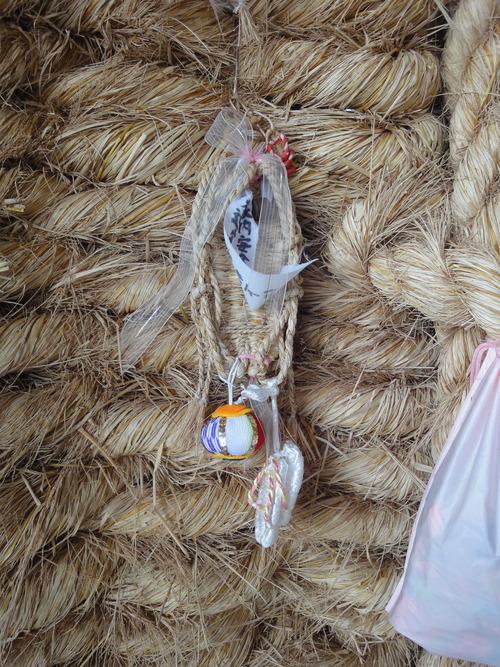
When Negoroji was established in the late 8th century, mountains were considered the best setting for meditation and prayer, and for honing spiritual powers through rigorous training.

A pilgrim on the 88 temple circuit
Thus, despite being located in Takamatsu city, the temple is set quite deep in a mountain and manages to retain a feeling of remoteness and tranquility. The stairs make for a good workout, too.

Within the temple grounds is the stump of an old Japanese zelkova tree.
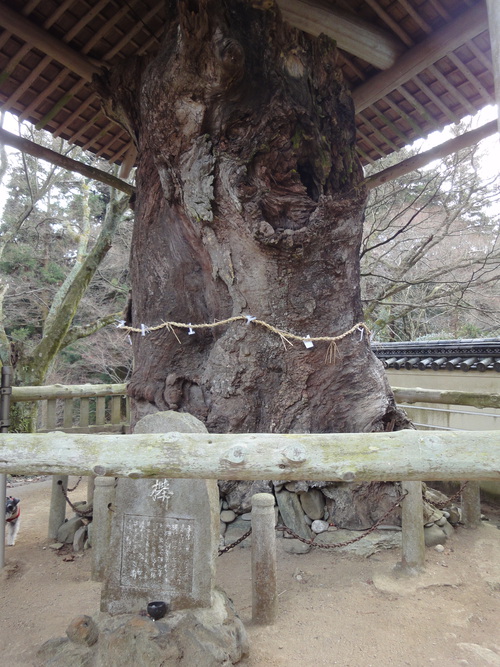
Legend has it that when the Buddhist priest Kobo Daishi (774-835?) founded the temple, a white monkey swung out of this tree to help him. People claim that the tree was 1600 years old when it died and the stump is still highly revered.
Before heading into the main temple, we dutifully cleansed ourselves with water

And bathed ourselves in incense smoke.

We rang the bell for good measure, too, as that seemed to be the thing to do, at least at New Year's anyway. (Please note that not all temple bells can be rung by just anyone who comes by or at any time of day or year.)


Inside the main temple,

we wound our way through lovely, atmospheric corridors, very dimly lit but occasionally opening onto the brilliant light of the temple courtyard. The corridors were lined to the ceiling with carved images of Kannon (Goddess of Mercy).
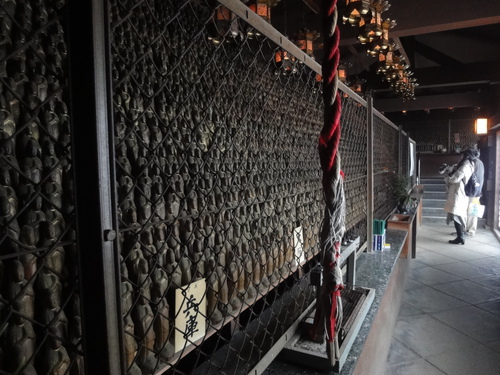
These Kannon statues, by the way, are one way to raise funds to build a temple. Supporters pay to have an image made and placed in the temple when it is built. Over 30,000 images line the corridors of Negoroji, and they come from many different parts of Japan.

Having prayed for a good year, it's tradition to pay 100 yen for a fortune.
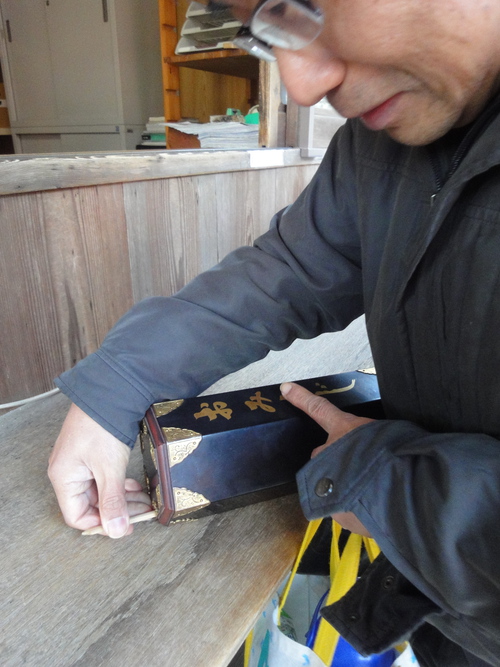
If you get a bad one, don't despair. Just tie it to the branch of a nearby tree to make sure the bad luck doesn't follow you out of the temple. As you can see from the photo below, you won't be the only one.

Car is the easiest way to get to Negoroji Temple. It is a little out of the way but I highly recommend it as does David at http://ogijima.com/negoroji/ .
See map below for access to Negoroji:
http://www.city.takamatsu.kagawa.jp/english/sightseeing/spot/negoroji.html
Takamatsu Access:
Takamatsu can be reached by direct flights from Tokyo’s Haneda Airport, by express bus from Kansai International Airport (3 hr), and by direct flights from China and Korea. It can also be reached by taking the bullet train to Okayama and changing to the Marine Liner bound for Takamatsu (runs every 1/2 hour; takes 1 hour). For more info see http://wikitravel.org/en/Takamatsu
Those giant straw sandals (waraji) on either side of the gate above are to protect travelers. Made every year by a group of volunteers, they scare off demons. After all, any guardian deity that could carry such a huge pair of sandals would have to be invincible, right?
I liked the way these particular sandals were strung with smaller pairs of sandals.
When Negoroji was established in the late 8th century, mountains were considered the best setting for meditation and prayer, and for honing spiritual powers through rigorous training.
A pilgrim on the 88 temple circuit
Thus, despite being located in Takamatsu city, the temple is set quite deep in a mountain and manages to retain a feeling of remoteness and tranquility. The stairs make for a good workout, too.
Within the temple grounds is the stump of an old Japanese zelkova tree.
Legend has it that when the Buddhist priest Kobo Daishi (774-835?) founded the temple, a white monkey swung out of this tree to help him. People claim that the tree was 1600 years old when it died and the stump is still highly revered.
Before heading into the main temple, we dutifully cleansed ourselves with water
And bathed ourselves in incense smoke.
We rang the bell for good measure, too, as that seemed to be the thing to do, at least at New Year's anyway. (Please note that not all temple bells can be rung by just anyone who comes by or at any time of day or year.)
Inside the main temple,
we wound our way through lovely, atmospheric corridors, very dimly lit but occasionally opening onto the brilliant light of the temple courtyard. The corridors were lined to the ceiling with carved images of Kannon (Goddess of Mercy).
These Kannon statues, by the way, are one way to raise funds to build a temple. Supporters pay to have an image made and placed in the temple when it is built. Over 30,000 images line the corridors of Negoroji, and they come from many different parts of Japan.
Having prayed for a good year, it's tradition to pay 100 yen for a fortune.
If you get a bad one, don't despair. Just tie it to the branch of a nearby tree to make sure the bad luck doesn't follow you out of the temple. As you can see from the photo below, you won't be the only one.
Car is the easiest way to get to Negoroji Temple. It is a little out of the way but I highly recommend it as does David at http://ogijima.com/negoroji/ .
See map below for access to Negoroji:
http://www.city.takamatsu.kagawa.jp/english/sightseeing/spot/negoroji.html
Takamatsu Access:
Takamatsu can be reached by direct flights from Tokyo’s Haneda Airport, by express bus from Kansai International Airport (3 hr), and by direct flights from China and Korea. It can also be reached by taking the bullet train to Okayama and changing to the Marine Liner bound for Takamatsu (runs every 1/2 hour; takes 1 hour). For more info see http://wikitravel.org/en/Takamatsu
Posted by cathy at
23:00
│Comments(0)



